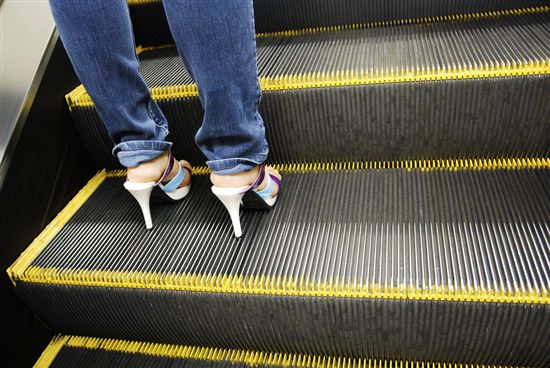23 Teenage Consumer Spending Statistics That Will Shock You
An old proverb holds that children are meant to be seen and not heard, but that's no longer the case. Here are 23 eye-popping statistics on how teens (and tweens) spend.
According to the U.S. Census Bureau, there are roughly 41 million kids in the U.S. between the ages of 10 and 19, which adds up to a lot of revenue for retailers. If you're curious about how that breaks down, read on.
 |
| © Tammy McGary (CC BY 2.0) via Flickr |
1. Clothing is the biggest teen spending trap
You'd think that as technologically savvy as today's teens are, they'd be spending most of their dough on the latest gadgets, but surprisingly, that's not the case. Investment management firm Piper Jaffray's Fall 2014 "Taking Stock With Teens" report found that clothing accounts for 21 percent of their budget. The average amount that upper income teens spend on clothes adds up to nearly $1,100 annually.
Tip: Best Time to Buy Clothes
2. But food is a close second
Going shopping for new outfits is one way to work up an appetite, and restaurants are seeing the younger dining crowd grow. According to the Piper Jaffray report, teens are allocating another 20 percent of their budget to food, which is up from the 15 percent they spent in years past. Among the most popular places to grab a bite are Starbucks, McDonald's, Taco Bell, and Chipotle.
Tip: Foods Worth Making from Scratch
3. The cost of the prom has gone down
Going to prom is one of high school's most important milestones, but for most teens, it comes with a big price tag. According to Visa's recent Prom Spending Survey, the average cost of getting all dolled up for the 2014 big dance was $978. While that seems like a lot, it's actually a 14 percent drop over 2013's average of $1,139.
4. Teens bring in some pretty big paydays
Getting your first job is a rite of passage for many teens. But while most jobs tend to pay on the lower end of the scale, the under 20-set is still raking in some pretty decent dough. Research compiled from MarketingVOX and the Rand Youth Poll estimates that the total amount of income paid to teens annually tops out at just over $91 billion. That's not too shabby, considering that most teens are only working part-time gigs.
Related: Best Job Search Site
5. Older teens earn the most
In addition to adding up how much teens earn as a whole, MarketingVOX and Rand also looked at what they're earning at different ages. Among the 15- to 17-year-old crowd, the average annual wage is just over $4,900. That's nearly double the $2,700 kids aged 12 to 14 are racking up. The difference is attributed to the fact that older teens are more likely to work at an outside job versus earning money by doing chores around the house (parents are meeting market wages, apparently).
6. Bad habits start early
While teenagers aren't exactly earning chump change, the amount they spend easily outpaces their paychecks. One of the most startling statistics to come out of the MarketingVOX/Rand research centers on teens' total annual spending, which sits just shy of $259 billion annually.
Tip: Kids and Money
7. Mom and Dad may be taking on debt to feed teen spending
If that figure is accurate, it means that teens are spending nearly triple what they earn. So where's the extra money coming from? Mom and Dad, of course. The survey also found that parents contribute roughly $158 million to the teen spending phenomenon every year. While teens get 27 percent of their income from working, 22 percent of it comes directly from their parents, according to a YMCA report.
Tip: How to Get Out of Debt
8. The teens strolling in malls rarely shop in them
 |
| © Paul Keller (CC BY 2.0) via Flickr |
Online shopping is king among teens. Approximately 79 percent of teen females and 76 percent of teen males involved in Piper Jaffray's Spring 2013 spending survey said they shop online. Nearly 70 percent of all teens said they prefer to browse the web version of their favorite stores versus visiting them in person, with Amazon ranking as the number one online shopping destination.
Tip: How to Avoid Overspending
9. Teens favor branded athletic gear over other clothing
Fashion-conscious teens are nothing if not loyal, especially when it comes to preferring certain brands over others. Nike continues to be the most popular, with 22 percent of teens surveyed in the Fall 2014 Taking Stock With Teens report citing it as their top pick for clothing and shoes. Some of the other brands rounding out the top 10 include American Eagle, Forever 21, Ralph Lauren, and Urban Outfitters.
10. But they're not above shopping for bargains
Just because teens prefer to sport gear from well-known retailers doesn't mean they're paying full price for all the things they buy. In fact, Piper Jaffray's 2013 spring survey revealed that the majority of them are actually hunting for deals at off-price stores like T.J. Maxx and Ross. Approximately 70 percent of girls and 55 percent of boys surveyed said they shop at these kinds of stores, and many of them agreed that it was popular thing to do.
11. Not all teens are spenders
Aside from gauging spending trends, MarketingVOX and the Rand Youth Poll also looked into how much teens are saving. Of more than 8,000 teens surveyed, 38 percent reported that they're actively saving money and 22 percent said they are saving more than they did the previous year. Fifty-seven percent of teens said they are saving money for new clothes while 36 percent are socking away cash to buy a car.
Tip: Best Time to Buy a Used Car
12. But many of them lack basic financial know-how
Teens are spending big, but for the most part, they have a very limited understanding of personal finance basics, like what the difference is between debit and credit cards. A 2012 poll from ING Direct and Capital One found that 87 percent of teens say they know little to nothing about managing money. While the majority of teens said they learn about money at home, close to 12 percent reported not having any kind of parental guidance on how to handle their finances, which could explain why they struggle to understand certain fundamental concepts.
Related: Financial Literacy Statistics
13. Credit card use among older teens isn't uncommon
The 2009 CARD Act has made it difficult for anyone under 21 to qualify for a credit card without sufficient income or a co-signer, but that doesn't mean some teens don’t have a walletful of plastic. According to Sallie Mae's 2013 "How America Pays for College" report, 14 percent of college freshmen reported having at least one credit card, with an average balance totaling $611 .
Related: Credit Cards and Teenagers
14. Teens are willing to pay more for technology
While spending on electronics and technology only accounts for about 7 percent of teen budgets, according to the Fall 2014 Taking Stock survey, young people are forking over big bucks to get top-of-the-line items. Sixty-seven percent of the teens included in the study reported having an iPhone, and Apple continues to rule the day when it comes to tablets. Eighty-three perfect preferred the iPad to Android devices, despite its steeper retail cost.
15. Money is already a source of stress for some teens
The economic downturn of the last few years has had a far-reaching impact, and not just for the grown-ups. For high school students, there's a lot of anxiety surrounding their financial futures. H&R Block's 2014 “Teens, Money and Stress” report found that 78 percent of young people are worried about getting in over their heads with student loan debt. Eighty percent are concerned about being able to find a good job, and nearly 6 in 10 are fearful about ending up worse off financially than their parents.
Related: Stress Statistics
16. They are sharing the burden of worrying about college
The price tag for a college degree is higher than ever, and the overwhelming majority of teens understand that planning ahead is important. According to the 2014 Teen College Savings Barometer Study, 93 percent of those surveyed said saving money for college is important to them, and 44 percent expect to pay around half the cost themselves. Of those who said they'll have to foot some of the bill for their education, 63 percent are actively saving towards that goal.
Tip: How to Pay for College
17. But the majority aren't keeping a budget
Learning how to make and stick to a budget is one of the building blocks of a solid financial education, but it's something that many teens have yet to master. The 2014 Teens and Personal Finance Survey from Junior Achievement and Allstate Insurance showed that 77 percent of teen boys and 63 percent of teen girls aged 16 to 18 are not keeping track of where their money goes on a regular basis.
18. They like to score Black Friday deals just like everyone else
Black Friday seems to start earlier and earlier every year, but it's not just adults who are camping out at the stores. Stage of Life, a website that hosts monthly writing contests for teens, conducted a survey in 2013 to gauge what young people think about Black Friday and consumerism in general. Of the 7,215 students who responded, 41 percent said they join in with the hordes of shoppers once Thanksgiving dinner has been cleared away.
Related: Deals
19. Shopping is not about getting things
Hanging out with friends is a priority for most teens, and a lot of them are strengthening their relationships by going on a spending spree. According to the Stage of Life survey, 61 percent of respondents said that shopping is a good way to bond with friends and family.
20. It's not just older kids who are driving the economy
Kids in the 10- to 13-year-old range are often lumped in with older teens when it comes to spending surveys, but they're quickly setting themselves apart as a dynamic force in the market. In 2012, a report from Digitas, which has since merged with LBi, estimated that tween spending power hovered somewhere around $1.2 trillion. This staggering figure demonstrates just how much influence they have over the brands and products their parents buy.
21. A lot of tween spending centers on what they wear
Tweens are just as picky as their older counterparts when it comes to the kinds of clothes they prefer. According to the NPD Group, tween apparel spending topped out at $14.4 billion for the August 2012 to July 2013 school year. That comes out to an average of $231 that parents shell out for back-to-school and another $69 a month that tweens spend on new clothes.
22. Instagram plays a big part in how teens spend
The Internet is an integral part of daily life for most young adults these days; according to Pew Research, 95 percent of teens are online and three out of four teens aged 12 to 17 access it via smartphones, tablets, and other mobile devices. The Spring 2014 Taking Stock report from Piper Jaffray found that more than half of teens said the Web impacts their purchases, with Instagram edging out Facebook and Twitter as their preferred social network.
23. But friends also have a strong influence
 |
| © Tammy McGary (CC BY 2.0) via Flickr |
While a lot of teens are getting ideas about what they should or shouldn't buy from what pops up in their news feeds, many of them still base their spending decisions on what they see in person and in the school hallways. Another survey from the NPD Group found that 36 percent of teens said word-of-mouth influenced the things they buy, with advertising and online reviews following closely behind.
Related: Signs Your Friends are Bad for Your Money
Rebecca Lake is a journalist at CreditDonkey, a credit card comparison and reviews website. Write to Rebecca Lake at rebecca@creditdonkey.com. Follow us on Twitter and Facebook for our latest posts.
Read Next:
